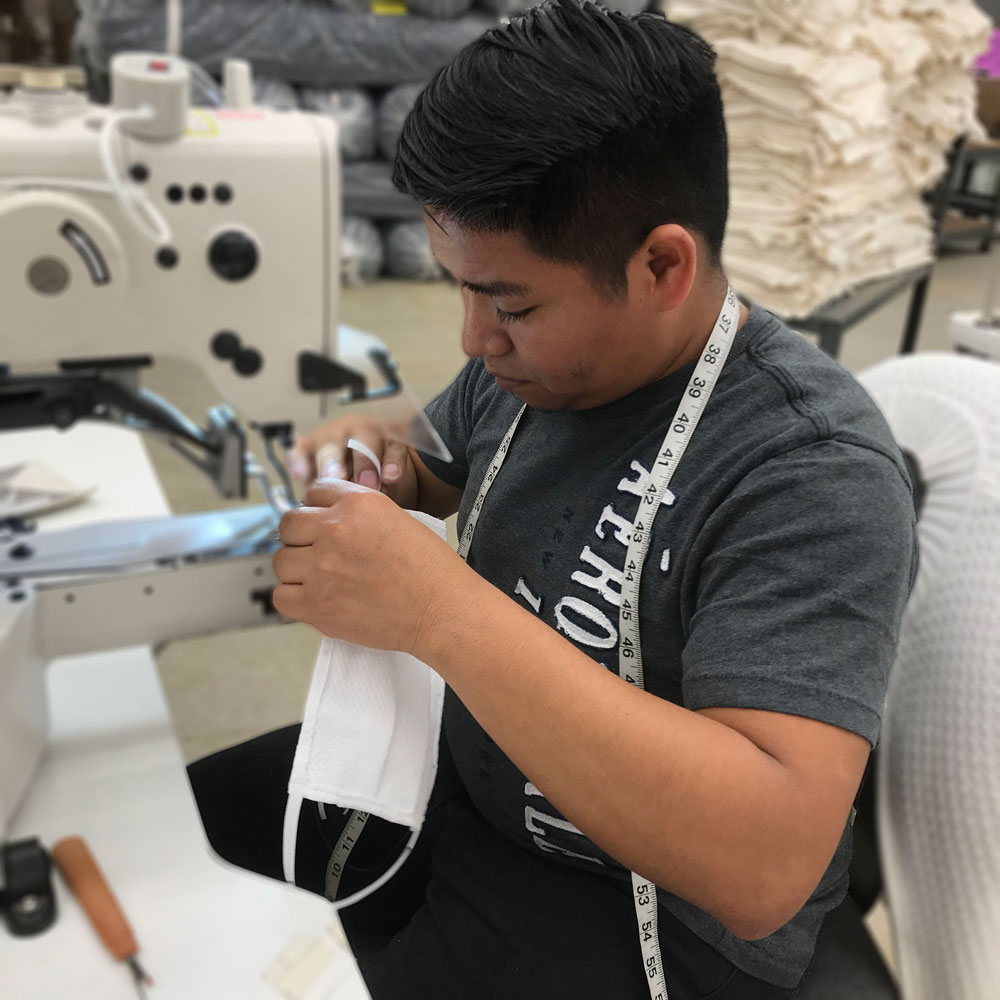

A half-century ago, in the early 1970s, an estimated 2.4 million Americans worked in textile manufacturing. Back then, three-quarters of the garments purchased by Americans were still produced in the US. By 2013, that number had fallen to two percent.
Yet in 2008, a group in western North Carolina came up with a seemingly off-the-wall idea: “Let’s start a textile factory.” That group became known as Opportunity Threads. Based in Valdese, a small town of 4,400 located about eight miles east of the “big city” of Morganton (population 16,500), the largely immigrant-based worker co-op today employs over 50 people and is part of a broader network, the Carolina Textile District, whose member businesses collectively employ around 250 people.
Then in mid-March, another seemingly absurd idea emerged: let’s stop sewing furniture covers, blankets, and specialty T-shirts and retool to make the personal protective equipment (PPE) needed by America’s frontline health care workers during the pandemic emergency. Now that idea too has become reality, with nearly 150,000 surgical masks in production this past week—and even more expected this week.
The story that has emerged has a number of lessons to teach. In one aspect, it is a heartwarming story of a community that came together and could. But it is also a story about the costs of globalization—and how supply-line choices made decades ago have come back to haunt our country in one of our hours of greatest need.
A Call from Doctors Sets an Industry in Motion
The grassroots effort started with a hospital request made at the end of the third week of March. Officials at Carolinas Healthcare System Blue Ridge reached out to David Bennett, chief financial officer and chief operating officer of EJ Victor, to ask if the furniture company could produce masks locally.
“As soon as we saw there was going to be a local need, we wanted to do anything we could to help,” Bennett said. “We are proud of the work we do in Morganton and happy to help locally right now as much as we can.”
Leading the mobilization effort are EJ Victor, Opportunity Threads, the Carolina Textile District (a group of over a dozen local businesses), an affiliated nonprofit known as Industrial Commons, and another nonprofit called Manufacturing Solutions Center, which assures quality control in production.
Aaron Dawson directs workforce development at Industrial Commons. Dawson and his colleague Bob Carswell, who is operations manager there, estimate that while only 250 or so work for members of the Caroline Textile District, regionally there are as many as 1,500 sewers and 80 companies. If this network were fully mobilized, it would be possible to produce over a million masks a week.
Dawson explains that traditionally Opportunity Threads has been a worker-owned, cut-and-sew shop that primarily makes specialty quilts “where loved ones can send in T-shirts from their family members or their own.”
“The workers cut T-shirts into squares and stitch them into quilts,” Dawson says. “They do orders for various companies. They have also sewn for Maggie’s Organics for their 100-percent organic vegetable cotton bags. That’s the kind of work they do.”
Retooling production from apparel and furniture production to sewing surgical masks and hospital gowns is doable, but it requires a prototyping process and, most critically, obtaining the appropriate materials. EJ Victor has agreed to have a 20,000-square-foot distribution facility serve as a central location to store and stage raw materials and supplies, distribute production kits, and collect finished masks.
An initial win: on March 20th, an initial run of 50 surgical masks was produced and delivered to Burke Primary Care as covers to N-95 respirators. These masks are washable and made of non-woven furniture fabric. EJ Victor provided the fabric and cut the material, and the covers were sewn at Opportunity Threads.
These washable surgical masks, or “covers,” are effective in blocking splashes and large-particle droplets, but, according to the US Food and Drug Administration (FDA), by design do “not filter or block very small particles in the air that may be transmitted by coughs, sneezes, or certain medical procedures. Surgical masks also do not provide complete protection from germs and other contaminants because of the loose fit between the surface of the face mask and your face.” They are not the same as N-95 respirators, which require a very particular type of fabric and are called N-95 because they block “at least 95 percent of very small (0.3 micron) test particles,” but they can be used to cover and thereby extend the use of an N-95 respirator. For a time, the Carolina group explored the possibility of producing the N-95 respirators, but securing the materials proved to be too difficult.
In theory, a textile worker, if properly equipped, should be able to sew about 150 masks a day. In other words, if the network were able to fully supply and mobilize 1,500 sewers, it would be possible to manufacture over 200,000 masks a day.
Of course, maintaining production amidst the pandemic is its own challenge. “We are disinfecting everything constantly. Changing gloves. Taking the utmost precaution so that workers are not getting sick,” Dawson notes.
Filling the Gap—and Ramping Up
Sara Chester is codirector of Industrial Commons. When they were getting started in the retooling effort, she noted that what propelled the initial effort was a plea from physicians, who noted that they were likely to run out of N-95s. “The best thing you can do is to make a washable cover,” the doctors implored.
It wasn’t just local doctors who were short of equipment, of course. In the US epicenter of the pandemic, in New York City, Cooperative Home Care Associates (CHCA), the nation’s largest worker co-op, was running out of masks for its homecare staff. Adria Powell, who heads the company of over 1,000 worker-owners, didn’t need N-95 respirators, but workers there did need ready access to surgical masks.
There is a lot at stake. Times are tough for CHCA. Powell estimates that the number of clients has fallen from 1,700 to 1,200 for a variety of reasons. Some clients don’t want care workers coming into their homes. In some cases, clients have sheltered in place with family members who are providing care, and—speaking to the dangers of providing home healthcare in the midst of a pandemic—a number of workers are in quarantine themselves. Powell said the count was 194 as of a week ago—and rising.
Powell notes that price gouging has made buying surgical masks exceedingly difficult, but she heard stories of seamstresses in Los Angeles who were sewing them. That led her to reach out to Molly Hemstreet, a founder of Opportunity Threads, who she knew through their common worker cooperative network.
“We were able to receive the first shipments at the end of the March,” Powell says. “We’ve been getting 500 masks a week, which is helping us stay ahead of running out of the masks that they had.” Powell estimates that CHCA uses about 1,500 masks a week.
Sign up for our free newsletters
Subscribe to NPQ's newsletters to have our top stories delivered directly to your inbox.
By signing up, you agree to our privacy policy and terms of use, and to receive messages from NPQ and our partners.
All told, Chester estimates that between March 20th and April 6th, Opportunity Threads produced initial small batch runs totaling 4,000 masks, or about 2,000 a week. “Some went to CHCA and some went to local schools and local doctors. Schools are doing feeding programs. A lot of them have been donated to the schools.”
Chester says that these 4,000 masks were produced during a ramp-up phase. It took one week to get the first batch produced, and two more weeks to do the initial sewing runs at Opportunity Threads.
“What makes our story unique,” she explains, is that “a lot of cut-and-sews don’t know anything about PPE or how to source it. They don’t have the capacity to find the raw materials. We are trying to coordinate production across 100 different manufacturers.”
Chester notes that the first mass batch of fabric only arrived in Morganton on April 7th and was meant for the so-called “pedestrian” masks that can be used by people seeking to abide by the cloth face covering recommendation of the Centers for Disease Control and Prevention (CDC).
Surgical covers, Chester says, must be washed every time you wear them and can last five washes. The pedestrian masks can last for 75 washes. “It is a step above cotton, woven, anti-microbial.”
Chester explains how production will work: “We have a standardized pattern. [Area companies] go online and can reserve a kit. We are not asking them to pay for the kits—we send the materials on good faith.” Chester adds that a company can order kits in units of 1,000 and can reserve from one to five kits. “People were champing at the bit,” she adds.
The way this works, a company orders a kit and commits to returning finished product within three, seven, or 14 days. “Some companies have 75 sewers and can do five kits [i.e., 5,000 masks] a day. An average sewer can sew 150 masks a day,” Chester explains.
In the first round of bidding on the afternoon of April 7th, Chester indicates that a total of 75 companies agreed to reserve kits. As a result, there are now 149,200 masks in production. This week, Chester indicates, the group has also gotten the material it needs to produce surgical masks at hospital gowns at scale, likewise using a “kit” system. The network anticipates producing 60,000 surgical masks this week—up from the 2,000 a week they have been producing—and 30,000 gowns.
In short, the prototyping phase is over—and mask and gown production in the Carolinas is now online.
These numbers are impressive, but Chester acknowledges that the need for masks and gowns is far greater. Chester estimates shortages of both masks and gowns exceed one million in North Carolina and says other states have similar gaps to fill.
Rethinking Our Supply Chains in the Global Economy
Eric Henry is CEO of TS Designs, a clothing shop that is member of the Carolina Textile District. “The lesson to be learned here is we have an opportunity to rebuild supply chains that are local, transparent, especially around apparel manufacturing,” notes Henry. “One thing COVID-19 has showed up is the weakness of a global economy.… We are not going to put the genie back in the global economy [bottle], but what we can do in the Carolinas is grow, process, and manufacture textiles.”
While Henry does not believe the global economy is going away, he does see a need to temper it. The failure of the system to supply needed PPE when it was needed, Henry notes, speaks to “the real costs and the weakness of the global economy.”
Henry is under no illusions that the Carolina mobilization is adequate to the need. That said, Henry sees the mobilization as having been highly beneficial, not just for everyone who needs masks, but for the textile businesses.
“Since you’re gearing up on something that you haven’t made in the past, you have a lot of inefficiencies,” Henry observes, so participating textile companies are not earning profits on the production, but mask and gown production does enable them to keep their workers employed, no small feat in an economy now marked by mass unemployment.
Henry notes that if his own business did not have a military supply contract, he would be seeing a 70-percent drop in business. If you design T-shirts for special events…well, there aren’t a lot of special events these days.
“We’ve laid off a lot of people,” Henry concedes.
One change Henry notes for his business is that because of the retooling, his business has “put in some sewing equipment to help with product development internally.” Henry adds, “It gives us the ability to have more flexibility down the road to help out if needed” and helps keep employment in place.
Henry believes local economic institutions are important, and he is glad that the Carolina Textile District was in place before the pandemic. “We are stronger as a group. I’m hoping we can learn from this and grow from this. Build more resilience for the next global disruption we might face. We’ve got to understand the weaknesses of the global economy.” He also hopes people will become “more hyperlocal” as a result of the economic shutdown experience, and the hard knowledge gained that when supply chains are broken, we all forced to depend on our neighbors—and the local economy.
Chester concurs with Henry; she adds she was “most pleasantly surprised” by the willingness of area manufacturers to effectively produce at cost. “It is nice that people are willing to do that to keep their folks employed and help in the crisis,” Chester says.
In terms of the potential to re-localize supply chains over time, Chester says one key to being able to hold on in North Carolina and build for the future has been the partnership between nonprofits, such as the Industrial Commons group she codirects, and area businesses.
Chester adds that, “The nonprofit sector is allowing us to help these small companies right now.” If the partnership didn’t exist, “a lot of companies wouldn’t make it. But because they can produce at cost and we have funding as nonprofits to help offset the gap, with this hybrid nonprofit-for-profit model, we can make all of this work.”













